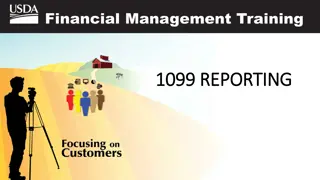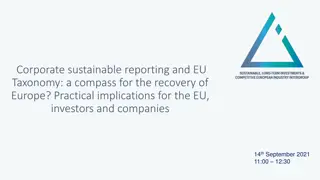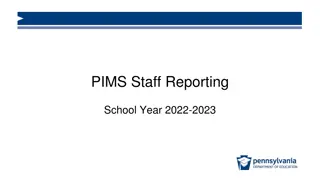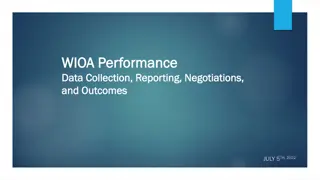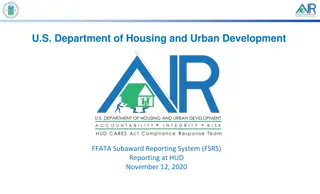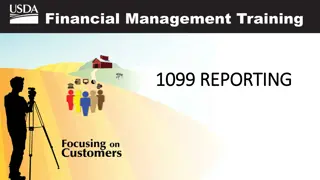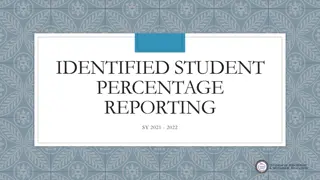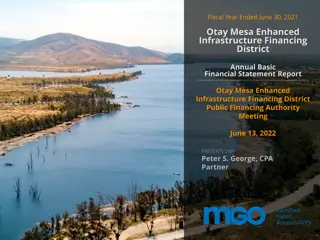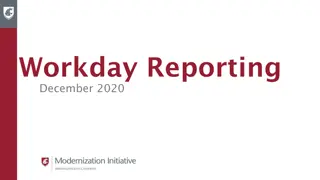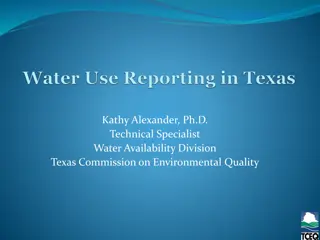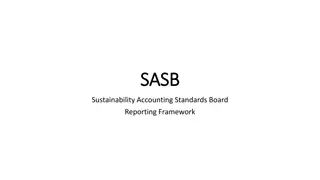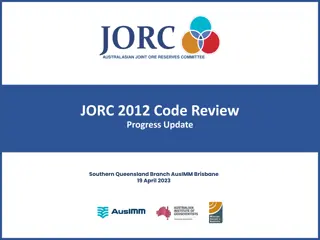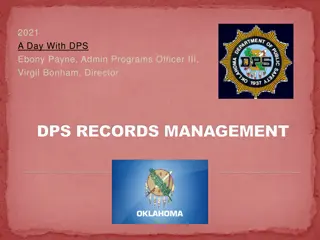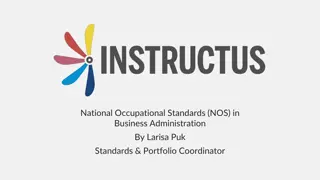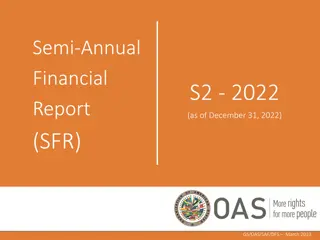Financial Reporting Standards Overview for 2021/2022 FY
Overview of financial reporting standards for the fiscal year 2021/2022 focusing on topics like mergers, transfers of functions, consolidated financial statements, events after the reporting date, accounting principles, related party disclosures, provisions, leases, and more. It also explores the development process of the modified cash standard and the importance of fair presentation in financial reporting.
Download Presentation

Please find below an Image/Link to download the presentation.
The content on the website is provided AS IS for your information and personal use only. It may not be sold, licensed, or shared on other websites without obtaining consent from the author. Download presentation by click this link. If you encounter any issues during the download, it is possible that the publisher has removed the file from their server.
E N D
Presentation Transcript
1 For 2021/2022 fy Summaries
CHAPTER 20 Mergers 22 CHAPTER 20 CHAPTER 19 CHAPTER 19 Transfers of Functions .21 CHAPTER 18 Consolidated Financial Statements 20 CHAPTER 18 CHAPTER 17 Events after the Reporting Date ..19 CHAPTER 17 CHAPTER 16 Accounting by Principals and Agents 18 CHAPTER 16 CHAPTER 15 CHAPTER 15 Related Party Disclosures .17 CHAPTER 14 Provisions and Contingents .16 CHAPTER 14 CHAPTER 13 CHAPTER 13 Leases .15 CHAPTER 12 Inventories .. 14 CHAPTER 12 CHAPTER 11 Capital Assets . 13 CHAPTER 11 CHAPTER 10 Treasury Financial Instruments .12 CHAPTER 10 CHAPTER 9 CHAPTER 9 General Departmental Assets and Liabilities .11 CHAPTER 8 CHAPTER 8 Expenditure 10 CHAPTER 7 CHAPTER 7 Revenue ..9 CHAPTER 6 Cash Flow Statement .8 CHAPTER 6 CHAPTER 5 CHAPTER 5 Appropriation Statement 7 CHAPTER 4 CHAPTER 4 Accounting Policies, Estimates and Errors ..6 CHAPTER 3 CHAPTER 3 Financial Statements Presentation . 5 CHAPTER 2 CHAPTER 2 Concepts and Principles.. 4 CHAPTER 1 CHAPTER 1 Preface to the Modified Cash Standard. ..3 General Departmental Assets and Liabilities .11 Expenditure 10 Revenue ..9 Cash Flow Statement .8 Appropriation Statement 7 Accounting Policies, Estimates and Errors ..6 Financial Statements Presentation . 5 Concepts and Principles.. 4 Preface to the Modified Cash Standard. ..3 Mergers 22 Transfers of Functions .21 Consolidated Financial Statements 20 Events after the Reporting Date ..19 Accounting by Principals and Agents 18 Related Party Disclosures .17 Provisions and Contingents .16 Leases .15 Inventories .. 14 Capital Assets . 13 Treasury Financial Instruments .12 Contents Contents 2
3 CHAPTER 1 CHAPTER 1 Preface to the Modified Cash Standard Preface to the Modified Cash Standard DUE PROCESS IN DEVELOPING THE MODIFIED CASH STANDARD MODIFIED CASH BASIS OF ACCOUNTING Pronouncements issued by Accounting Standards Board; International Public Sector Accounting Standards Board International Accounting Standards Board Other organisations that develop financial reporting, accounting and auditing requirements for the public sector Due process.. Research to identify issues Identify solution with reference to existing concepts and principles, pronouncements or legislation Draft MCS exposed for comment Comments received are reviewed and MCS amended (where appropriate) Under the modified cash basis of accounting the department recognises only certain elements in its statement of financial performance and statement of financial position, while others are recorded in the notes to the financial statements. The element recognised are when they arise from cash inflows and outflows. FAIR PRESENTATION OVERRIDE Also consider.. Best practices, locally and internationally Capacity of departments to comply with the reporting requirements Systems used by departments in preparing and collating the information In extremely rare circumstances when management, in consultation with the OAG, concludes that compliance with a requirement of the MCS would be so misleading that it would conflict with the overall objectives of the MCS with regard to fair presentation, the department departs from that requirement and discloses: That management has concluded that the financial statements present fairly the department s primary and secondary information; That the department complied with the MCS except that it has departed from a particular requirement to achieve fair presentation; and The requirement from which the department has departed, the nature of the departure and the reasons for the departure; The financial impact of the departure (where practicable).
4 CHAPTER 2 CHAPTER 2 Concepts and Principles Concepts and Principles QUALITATIVE CHARACTERISTICS OBJECTIVE OF FINANCIAL STATEMENTS Relevance Relevant information is information that is decision useful and can help users to evaluate past, present and future evets, or confirming or correcting past evaluations. The relevance of information is established by reference to the nature and the materiality of the information concerned. Understandability Information must be understandable to an average user who has reasonable knowledge of government, the department s activities and environment, accounting and a willingness to study the information with reasonable diligence. To present a true and fair view of the financial performance, financial position, changes in net assets and cash flows and other disclosures that is useful to a wide range of users, and to provide additional information that would be useful for decision making. Comparability Information should be comparable to enable users to identify trends and to assess performance over time and between similar entities. Reliability Information is reliable when it does not contain material errors and is free from bias. RECOGNITION AND RECORDING OF ELEMENTS ELEMENTS OF FINANCIAL STATEMENTS Recognition is the process of incorporating in financial statements an item that meets the definition of an element and satisfies the criteria for recognition, i.e. if: It results in an immediate cash in- or outflow; or It is readily convertible to known amounts of cash; and The item has a cost or value that can be measured reliably. LIABILITIES ASSETS An asset is a resource controlled by the department as a result of past events and from which future economic benefits or service potential is expected to flow to the department A liability is a present obligation of the department arising from past events, the settlement of which is expected to result in an outflow of resources embodying economic benefits or service potential. Economic benefits assets that are used to generate net cash inflows Service potential assets that do not directly generate net cash inflows REVENUE Recording is the process of capturing the financial information relating to a particular transaction, event, asset or liability in the electronic or manual records for the purpose of disclosure as secondary information Revenue is the gross inflow of economic benefits or service potential during the reporting period when those inflows result in an increase in net assets, other than increases relating to capital contributions to net assets. EXPENSES MEASUREMENT Expenses are decreases in economic benefits or service potential during the reporting period in the form of outflows or incurrences of liabilities that result in decreases in net assets, other than those relating to capital distributions from net assets. Measurement is the process of determining the monetary amounts for recognition and or recording in the financial statements at: Historical cost amount of cash or cash equivalents received or paid for fair value for non-cash transactions; Fair value amount for which an asset could be exchanged or liability settled between knowledgeable willing parties at arms length NET ASSETS Net assets are the residual that remains after deducting all of the department s recognised liabilities from its recognised assets.
5 CHAPTER 3 CHAPTER 3 Presentation of Financial Statements Presentation of Financial Statements OVERALL CONSIDERATIONS Presentation consistency Retain presentation and classification from one period to the next. Offsetting Offsetting of assets and liabilities or revenue and expenses are not permitted unless required or permitted by MCS or legislation. Fair presentation and compliance with MCS Financial statements are required to present fairly the financial position, financial performance and cash flows. Financial statements complying with MCS is presumed to result in fair presentation. Going concern Financial statements are prepared on a going concern basis (where significant doubt on ability to continue as going concern or meet obligations when due, uncertainties are disclosed). Primary and secondary financial information Primary financial information comprise of recognised revenue, expenses, assets and liabilities Secondary financial information provides additional information about revenue, expenses, assets and liabilities that have been recorded but don t qualify for recognition. Comparative information At least one year of comparative information. Materiality and aggregation Each material class of similar assets and items of dissimilar nature or function is to be presented separately. COMPONENTS OF FINANCIAL STATEMENTS STRUCTURE AND CONTENT A complete set of financial statements comprises: Statement of financial position Statement of financial performance Statement of changes in net assets Cash flow statement Appropriation statement Notes to the primary and secondary financial information, including of significant accounting policies All statements are required to be presented with equal prominence. STATEMENT OF FINANCIAL POSITION STATEMENT OF FINANCIAL PERFORMANCE Present current and non-current items separately All items of revenue and expense recognised in the period are included in surplus or deficit. The Economic Reporting Format is the standard for the classification of expenditure. Current assets Expected to be realised in, or is intended for sale or consumption in the normal operating cycle Held primarily for trading Expected to be realised within 12 months Cash or cash equivalents (unless restricted). All other assets are required to be classified as non-current. Current liabilities Expected to be settled in the normal operating cycle Held primarily for trading Due to be settled within 12 months All other liabilities are to be classified as non-current. NOTES TO THE FINANCIAL STATEMENTS Presents information about the basis of preparation and specific accounting policies used, may disclose judgements by management in applying the accounting policies that have a significant effect on the amounts recognised in the financial statements.
CHAPTER 4 CHAPTER 4 Accounting Policies, Changes in Accounting Accounting Policies, Changes in Accounting Estimates and Errors Estimates and Errors 6 ACCOUNTING POLICIES ERRORS CHANGES IN ACCOUNTING ESTIMATES DEFINITION DEFINITION DEFINITION Prior period errors are omissions from and misstatements in the financial statements for one or more prior periods arising from failure to use/misuse of reliable information that: was available when the financial statements for that period are authorised for issue; and could have been reasonably expected to have been obtained and taken into account in the preparation and presentation of the financial statements. Errors include: Mathematical mistakes Mistakes in applying accounting policies Oversights and misinterpretation of facts Fraud Accounting policies are specific principles, bases, conventions, rules and practices applied in preparing, presenting and disclosing information in the financial statements. A change in an accounting estimate is an adjustment of the carrying amount of an asset or liability, or the amount of periodic consumption, resulting from assessing the present status of, and the expected future benefits and obligations associated with, the asset or liability. Selection and application of accounting policies: If a Chapter deals with a transaction, use the Chapter If no Chapter on a transaction, management judgment should be applied in developing and applying an accounting policy resulting in information that is relevant, reliable and complete in all material respects Only change a policy if the change is required by the MCS Principle: Recognise the change prospectively in surplus or deficit in: Period of change, if the change only affects that period; or Period of change and future periods (if the change affects both) Principle: Apply changes in accounting policies: If change is due to a new Chapter of MCS apply transitional provisions; If no transitional provisions apply retrospectively The following sources should be referred to, to make judgment: Office of the Accountant-General Definitions, recognition criteria and measurement concepts for assets, liabilities, revenue and expenses in Chapter 2 on Concepts and Principles Principle: Correct all errors retrospectively. Restate the comparative amounts for prior periods in which error occurred OR if the error occurred before that date, restate opening balance of assets, liabilities and net assets for the earliest period presented If impractical to determine period specific effects or cumulative effects of the change in policy, then prospectively apply to earliest period that is practical Consistency of accounting policies accounting polices should be consistent for similar transactions, events or conditions unless required or permitted otherwise by the MCS If impractical to determine cumulative effects o the error, restate comparative information for the earlies period practicable If impractical to determine period specific effects of error, restate opening balances for earliest period practicable
7 CHAPTER 5 CHAPTER 5 Appropriation Statement Appropriation Statement DEFINITIONS PURPOSE OF APPROPRIATION STATEMENT Appropriation is an authorisation granted by Parliament and or the legislatures approving the budget to allocate funds for purposes specified by Parliament and or the legislatures. Actual amounts describe amounts that result from execution of the budget. Final budget is the approved budget adjusted for transfers, allocations, supplemental appropriations, and other changes applicable to the budget period. The appropriation statement provides the users of the financial statements with an indication of how the department utilised its budget to achieve its strategic objectives. APPROPRIATION STATEMENT A comparison of the approved, final budget and actual amounts is included in the financial statement as an additional statement (referred to as the appropriation statement). The appropriation statement includes the following for each program and sub-program: the adjusted appropriation, the shifting of funds within that appropriation, virements and final appropriation; the actual expenditure incurred; variances, if any, between actual expenditure and the final appropriation as well as actual expenditure as % of final appropriation; and s reconciliation of the budget with the statement of financial performance. (comparative information is provided for the appropriation per programme and sub-programme as well as per economic classification) NOTES TO THE APPROPRIATION STATEMENT Includes an explanation of material differences between the budget and actual amounts as well as an explanation of any classification differences between the appropriation statement and the statement of financial performance.
8 CHAPTER 6 CHAPTER 6 Cash Flow Statement Cash Flow Statement COMPONENTS OF A CASH FLOW STATEMENT Operating Activities These are the principal activities of the department that are not investing or financing activities. Investing Activities These relate to the acquisition and disposal of capital assets and other investments that are not included in cash equivalents. Financing Activities These relate to the activities that cause changes to the size and composition to the contributed capital and borrowings of the department. Interests and dividends received/paid may be classified as operating, investing or financing, based on its nature and as long as they are consistently treated from period to period. DEFINITION: CASH AND CASH EQUIVALENTS REPORTING CASH FLOWS FROM OPERATING ACTIVITIES Cash and cash equivalents are: Short-term (where the original maturity is 3 months or less, irrespective of maturity timing post reporting date) Highly liquid investments Readily convertible to known amounts of cash Subject to insignificant risk of change in value Cash flows from operating activities must be reported using the direct method. DIRECT METHOD Major classes of gross cash receipts and gross payments are disclosed (per economic classification). A reconciliation of net cash from operating activities with the surplus or deficit on the statement of financial performance is provided in the notes to the financial statements. CONSIDERATIONS TO NOTE Non-cash investing and financing activities must be recorded separately elsewhere in the financial statements Cash flow must be reported GROSS, set-off is permitted in very limited cases Foreign exchange transactions should be recorded at the rate at the date of the cash flow Assets and liabilities denominated in a foreign currency generally include an element of unrealised exchange difference at the reporting date Disclose components of cash equivalents and reconciliation to the statement of financial position amount
9 CHAPTER 7 CHAPTER 7 Revenue Revenue DEFINITIONS MEASUREMENT Revenue is recognised at the cash amount received. Cash receipts from transactions in a foreign currency is recognised in South African Rand by applying to the foreign currency amount the spot exchange rate at the date of the receipts Aid assistance comprise of amounts received from local and/or international donors in terms of a technical assistance agreement as well as amounts appropriated from the Criminal Asset Recovery Account. Appropriated funds comprise of departmental allocations as well as direct charges against the revenue fund (i.e. statutory appropriations). Departmental revenue is the inflow of cash arising in the course of ordinary activities of the department, normally from the sale of goods and/or assets, the rendering of services, and the earning of interest, taxes and dividends. RECOGNITION APPROPRIATED FUNDS DEPARTMENTAL REVENUE AID ASSISTANCE Departmental revenue is recognised in the statement of financial performance on the date that the cash is received. Departmental revenue is collected by national / provincial departments and is subsequently paid over to the national/provincial revenue fund. Appropriated funds are recognised in the financial statements on the date the appropriation becomes effective. Adjustments made in terms of the adjustments budget process are recognised on the date the adjustments become effective. Aid assistance in the form of donations are received under terms and conditions as agreed between the department and donor and is recognised when the cash is received.
10 CHAPTER 8 CHAPTER 8 Expenditure Expenditure DEFINITIONS MEASUREMENT Expenditure is measured at the cash amount paid to settle the expenditure incurred. Cash payments arising from a transaction in foreign currency is recognised in South African Rand by applying the spot rate at the date of the cash flow. Date of payment is the date on which the expenditure is authorised for payment (but no later than the last day of the reporting period). RECOGNITION Expenditure is recognised in the statement of financial performance on the date of payment. As a practical expedient, there is a rebuttable presumption that when a department authorises a payment on its system, the likelihood of this payment not occurring is remote and the department can recognise the expense. However where there is evidence to the contrary, the department makes appropriate adjustments to ensure that expenses are recognised on the actual date that the cash flow occurred.
11 CHAPTER 9 CHAPTER 9 General Departmental Assets and Liabilities General Departmental Assets and Liabilities DEFINITIONS Payables not recognised are liabilities to pay for goods or services that have been received or supplied and have not been invoiced or formally agreed with the supplier or recipient (and include payments in respect of social benefits where formal agreements for specified amounts exist). Accruals are liabilities to pay for goods or services that have been received or supplied but have not been paid and have not been invoiced or formally agreed with the supplier or recipient, including amounts due to employees. Prepayment is a payment made in advance of the goods, services or capital assets that are yet to be received and in the case of transfers and subsidies cash is yet to be earned by the recipient, in accordance with the agreement under which the payment is made. Advance received comprise of funds received in advance of goods/services that are yet to be delivered by the department in accordance with the agreement under which the advance is received. Advance paid comprise of funds paid in advance of goods, services or capital assets that are yet to be delivered to the department, and in the case of transfers and subsidies cash is yet to be earned by the recipient, in accordance with the agreement under which the advance is paid. RECORDING AN MEASUREMENT OF FINANCIAL ASSETS AND LIABILITIES (SECONDARY INFORMATION) Initial recognition and measurement- A financial asset or liability (not recognised) is recorded, when and only when the department becomes a party to the contractual provisions and .. RECOGNITION AND MEASUREMENT OF FINANCIAL ASSETS / LIABILITIES, PREPAYMENTS AND ADVANCES (PRIMARY INFORMATION) For accrued payables when goods are received, or services delivered or when transfers are due and payable recognised at cost. For accrued revenue when (a) it is probable that associated economic benefits / service potential will flow, (b) amount (being fair value) can be measured reliably and . Initial recognition and measurement A financial asset, liability, prepayment or advance is recognised when and only when the department becomes a party to the provisions of the arrangement, and one or the following additional criteria are met: the instrument is cash, or a cash equivalent under the control of the department; the financial asset or liability, prepayment or advance initially arose from a cash transaction; or the financial asset is a capital investment. For sale of goods.. Transferred significant risks and rewards of ownership of goods; No managerial involvement retained nor effective control Costs can be measured reliably For rendering of services.. The stage of completion can be measured reliably Cost can be measured reliably All financial assets impaired (where indication exists) When a financial asset or liability is recognised, it is measured at its cost plus transaction costs. A prepayment or advance is initially measured at cost. For taxes the mounts have been collected by third parties Subsequent measurement Financial assets and liabilities are subsequently measured at cost less amounts already settled or written-off, except for recognised loans and receivables, which are measured at cost plus accrued interest, where interest is charged, less amounts already settled or written off. Prepayments and advances are subsequently measured at cost. DERECOGNITION AND REMOVAL A financial asset only when (a) the contractual rights to the cash flow expire, are settled or waived, or (b) transfer all risks and rewards of ownership to another party. For a prepayment or advance when goods/ services are received or funds utilised A financial liability (or part thereof) only when, it is extinguished i.e. when the obligation specified in the contract is discharged, cancelled, expires or is waived
12 CHAPTER 10 CHAPTER 10 Treasury Financial Instruments Treasury Financial Instruments DEFINITIONS DISTINGUISHING LIABILITIES AND RESIDUAL INTERESTS The instrument is a residual instrument if the instrument includes no contractual obligation to: Deliver cash or another financial asset; or Exchange financial assets or financial liabilities under conditions that are potentially unfavourable to the issuer Issuer classifies a financial instrument, or its component parts, on initial recognition as a financial liability, financial asset or residual interest in accordance with the substance of the contractual arrangement and the definitions of a financial asset, financial liability and a residual instrument Amortised cost of a financial asset or liability is the amount at which the financial asset or liability is measured at initial recognition minus principal repayments, plus or minus the cumulative amortisation using the coupon rate. Cost method is the method used to account for financial instruments that requires such instruments to be measured at their transaction amount, plus any accrued interest and other charges, less amounts derecognised. DERECOGNITION OF FINANCIAL ASSETS Settlement value of an instrument is the amount that would be required to extinguish any right to cash or obligation to deliver cash related to the instrument at a specific point in time. Derecognise only when: The contractual rights to the cash flows from the financial asset expire, are settled or waived, or Substantially all the risks and rewards of ownership are transferred to another party Difference between carrying amount and the sum of the consideration received (including any new asset obtained less any new liability assumed) is recognised in surplus or deficit RECOGNITION AND MEASUREMENT OF FINANCIAL ASSETS / LIABILITIES (PRIMARY INFORMATION) Initial recognition and measurement A financial asset or financial liability is recognised at its face value when the department becomes a party to the contractual provisions of the arrangement. A department may designate a financial instrument to be measured at its transaction amount (i.e. the amount that was received in cash on the date of issue). Transaction or other costs are expensed. DERECOGNITION OF FINANCIAL LIABILITIES Derecognise only when: It is extinguished (when the obligation specified in the contract is discharged, cancelled, expires or waived. Instrument is exchanged with substantially different terms Substantial modification of terms (or part of it) Difference between carrying amount of a financial liability (or part thereof) extinguished or transferred and the consideration paid, including any non-cash assets transferred or liabilities assumed, recognised in surplus or deficit Subsequent measurement . Cost method transaction amount is changed to reflect any (where applicable): change in the foreign exchange rate recognised as revenue or expense interest capitalised recognised as revenue or expense amounts derecognised Alternative method designated for non- derivative instruments with fixt or determinable payments: Amortised cost gain or loss in surplus or deficit when derecognised or amortised Settlement value gain or loss in surplus or deficit when derecognised or revalued
13 CHAPTER 11 CHAPTER 11 Capital Assets Capital Assets REMOVAL DEFINITIONS INITIAL RECORDING Removed . On disposal, or When no future economic benefits or service potential are expected from its use Capital assets are non-current tangible or intangible assets Recorded when: It meets the definition of an asset; It is probable that future economic benefits or service potential associated with the item will flow to the department; and The cost or fair value of the item can be measured reliably In addition: For immovable assets (apply specific interim arrangements) For intangible assets (a) it is separable and (b) arises from a binding arrangement Tangible assets are non-monetary assets having physical substance that: a) Are held for use in the production or supply of goods or services, for rental to others, or for administrative purposes or for the development, construction, maintenance or repair of other capital assets; and b) Are expected to be used during more than one reporting period All proceeds recognised as revenue when received Intangible assets are identifiable non-monetary assets without physical substance INITIAL MEASUREMENT SUBSEQUENT MEASUREMENT All capital assets, except for biological assets, are subsequently measured at cost (deemed cost) Biological assets may be measured at fair value Any subsequent expenditure that is of a capital nature is added to the cost of that asset unless it relates to a project that spans over more than one year, in which case these costs are accumulated as work-in-progress and added to the cost of the asset when it is ready for use Day-to-day servicing and maintenance on a capital asset is expensed when paid Capital assets are not depreciated nor subsequently impaired MOVABLE ASSETS IMMOVABLE ASSETS Immovable asset Movable asset Acquired in non-exchange transaction Acquired in exchange transaction Acquired in non- exchange transaction Acquired in exchange transaction Can cost be determined reliably? Record asset fair value or R1 / R1,000 N Record asset at fair value From a non-government institution? Record asset at value received Can cost be determined reliably? Record asset fair value or R1 N N Y Y Y N Acquired prior to 1 April 2002? Record asset at fair value Record asset at cost Record asset at cost Y **Fair value = deemed cost Record asset at fair value else R1
14 CHAPTER 12 CHAPTER 12 Inventories *Chapter *Chapter not effective not effective Inventories COST DEFINITION Inventories are assets: In the form of materials or supplies to be consumed in the production process; In the form of materials to be consumed or distributed in the rendering of services; held for sale or distribution in the ordinary course of operations, or In the process of production for sale or distribution Includes Cost of purchase, including taxes, transport and handling A deduction of trade or cash discounts and volume rebates Cost of conversion Other costs to bring inventories to its present condition and location Excludes Anormal waste Storage costs Administrative overheads not related to production Forex differences Selling costs Interest costs (where settlement is deferred) MEASUREMENT AFTER RECOGNTION Lower of INITIAL RECORDING Inventories are recorded as assets, if and only if: it is probable that future economic benefits or service potential associated with the item will flow to the entity, and the cost of the inventories can be measured reliably NET REALISABLE VALUE (NRV) CURRENT REPLACEMENT COST (CRC) Applies to inventories to be distributed at no charge or for a nominal charge Does not apply to inventories to be distributed at no charge or for a nominal charge INITIAL MEASUREMENT Current replacement cost is the cost the entity would incur to acquire the asset on the reporting date Net realisable value is the estimated selling price in the ordinary course of operation, less the estimate costs to make the sale, exchange or distribution Inventories that qualify for recording as assets are initially measured at cost Where inventories are acquired through a non-exchange transaction, their cost is measured at fair value as at the date of acquisition Cost formulas: For non-interchangeable items: Specific identification of individual costs May use standard cost method if results in approximate cost For interchangeable items use weighted average The standard cost method takes into account normal levels of materials and supplies, labour, efficiency and capacity utilisation. They are regularly reviewed and, if necessary, revised in the light of current conditions Use of the LIFO method is prohibited and FIFO not permitted
15 CHAPTER 13 CHAPTER 13 Leases Leases DEFINITION A lease is an agreement whereby the lessor conveys to the lessee in return for a series of payments the right to use an asset for an agreed period of time A finance lease is a lease that transfers substantially all the risks and rewards incidental to ownership of an asset. Title may or may not eventually be transferred An operating lease is a lease other than a finance lease ACCOUNTING TREATMENT ACCOUNTING TREATMENT CLASSIFICATION OF A FINANCE LEASE Lessee: Treats contract as an executory contract Recognises payments as current expense Lessor: Treats contract as an executory contract Retains leased asset Recognises lease payments received as revenue Examples of situations that would ordinarily lead to a lease being classified as a finance lease (not all need to be met): The lease transfers ownership of the asset to the lessee by the end of the lease term The lease has a bargain option to purchase the leased asset at it is reasonably certain at that date of inception that the option will be exercised The lease term is for the major part of the economic life of the asset even if title is not transferred At the inception of the lease the present value of the minimum lease payments amounts to substantially all of the fair value of the leased asset The leased assets are of such specialised nature that only the lessee can use them without major modifications The leased assets cannot easily be replaced by another asset Lessor: Recognise lease payments received as revenue Retains leased asset, removed on expiry of lease Lessee: Recognises payments as capital expenses At the end of lease term, recognise leased assets acquired at (a) cost, being the fair value of the leased asset, if lower (b) the sum of the minimum lease payments made, including any payments made to acquire ownership at the end of the else term, excluding interest SALE AND LEASEBACK Lessee: Sale proceeds recognised as revenue (if reduction in lease payments instead of cash from sale disclose this fact) Remove asset on date of sale Lessor: Records and discloses the acquisition of the capital asset in accordance with Chapter 11 on Capital Assets Remove asset if ownership transfers at end of lease term Treats subsequent lease in accordance with Chapter 13 Overriding principle: Substance over form Other indicators of situations that individually or in combination could also lead to a lease being classified as a finance lease: If the lessee can cancel the lease, the lessor s losses associated with the lease are borne by the lessor Gains or losses from the fluctuation in the fair value of the residual value accrue to the lessee The lessee has the ability to continue the lease for a secondary period at a rent that is substantially lower than market rent
16 CHAPTER 14 CHAPTER 14 Provisions and Contingents Provisions and Contingents Principal: Provisions should only be recorded when there is a liability. Thus, only genuine present obligations are recorded and not planned future expenditure DEFINITIONS A provision is a liability of uncertain timing or amount A contingent liability is: A possible obligation that arises from past events, and whose existence will be confirmed only by the occurrence or non-occurrence of one or more uncertain future events not wholly within the control of the department, or A present obligation that arises from past events but is not recognised because it is not probable that an outflow of resources embodying economic benefits or service potential will be required to settle the obligation or the amount of the obligation cannot be measured with sufficient reliability A contingent asset is a possible asset that arises from past events, and whose existence will be confirmed only by the occurrence or non-occurrence of one or more uncertain future event not wholly within the control of the department RECORDING Provisions are recorded when: The department has a present legal or constructive obligation as a result of a past event It is probable ( more likely than not ) that an outflow of economic benefits or service potential will be required to settle the obligation, and A reliable estimate can be made of the amount of the obligation Contingent assets are recorded where an inflow of economic benefits or service potential is probable Contingent liabilities recorded unless the outflow of economic benefits or service potential is remote ONEROUS CONTRACTS An onerous contract is one where the unavoidable costs of meeting the obligations under the contract exceed the economic benefits or service potential expected to be received under it For onerous contracts, the provision is recognised and measured at the best estimate of the funds required to settle the present obligation MEASUREMENT The amount recorded should be the best estimate of the funds required to settle the present obligation at the reporting date (the time value of money is ignored). This means: Provisions for one-off events are measured at the most likely outcome Provisions are large populations of events (warranties) are measured at a probability-weighted expected value In reaching this best estimate, the entity takes into account the risks and uncertainties that surround the underlying events Reimbursements from 3rd parties for some or all expenditure required to settle a provision are recorded only when it is virtually certain that the reimbursement will be received. The reimbursement is treated as a separate asset, which cannot exceed the amount of the provision. Provisions are reviewed at each reporting date and adjusted to reflect the current best estimate, if it is no longer probable that an outflow of economic benefits will be required to settle the obligation, the provision is reversed. In measuring provisions, consider future events as follows: forecast reasonable change in applying existing technology (cannot predict discovery of new technology); ignore possible gains on sale of assets; and consider changes in legislation only if it is virtually certain to be enacted
17 CHAPTER 15 CHAPTER 15 Related Party Disclosures Related Party Disclosures DISCLOSURES DEFINITIONS A related party is a person or entity with the ability to control or jointly control the other entity, or exercise significant influence over the other party, or visa versa, or an entity that is subject to common control, or joint control A related party transaction is a transfer of resources, services or obligations between the reporting entity and a related party, regardless of whether a price is charged Relationships where control exists Regardless of whether there have been transactions, disclosure the list and nature of related party relationships with government entities (including departments) falling under its Minister/MEC s portfolio Related party transactions Only if there have been transactions, disclose: Related party revenue and expenditure per major category Total balances of receivables and payables Balance of loans made to or from related parties Contingent liabilities In-kind goods / services received or provided Key management personnel compensation Disclose in total, for each class of management, the following categories: Compensation paid Payments made to close family members of key management personnel Number of key management personnel A person or a close member of that person s family is related to a department if that person: Has control over the department Is a member of management of the department or its executive authority An entity is related to the department if any of the following conditions apply: The entity is a member of the same economic entity; The entity is controlled or jointly controlled by a person or close member of that person s family identified as a related party A person or close member of that person s family identified as a related party has significant influence over that entity or is a member of management of that entity or its controlling entity Exemption from disclosures if the transaction occurs within Normal supplier and/or client/recipient relationship and T&Cs
18 CHAPTER 16 CHAPTER 16 Accounting by Principals and Agents Accounting by Principals and Agents DEFINITIONS Principle: Before accounting for an arrangement with another party, a department should consider whether Chapter 16 should be applied. As it provides guidance on assessing the nature of an arrangement, it is considered before applying other Chapters of MCS. STEP 1: IDENTIFY THE BINDING ARRANGEMENT STEP 2: IDENTIFY THE TRANSACTIONS WITH THIRD PARTIES An agent is an entity that has been directed by another entity (a principal), through a binding arrangement, to undertake transactions with third parties on behalf of the principal and for the benefit of the principal A principal is an entity that directs another entity (an agent), through a binding arrangement, to undertake transactions with third parties on behalf, and for the benefit, of another entity (the principal) A principal-agent arrangement results from a binding arrangement in which one entity (an agent), undertakes transactions with third parties on behalf, and for the benefit of, another entity (the principal) A binding arrangement is any arrangement that confers enforceable rights and obligations on parties to the arrangement. These rights and obligations could arise from: contracts; legislation or similar means, and/or common law Transactions with third parties includes the execution of a specific transaction with a third party, e.g. a sale or purchase transaction, but also includes interactions with third parties, e.g. when the agent is able to negotiate with third parties on the principal s behalf. A key characteristic of these transactions is often that the principal and the third parties are the counterparties to the transaction rather than the agent and the third parties (although there are exceptions). STEP 3: IDENTIFY PRINCIPAL AND THE AGENT IN THE ARRANGEMENT An entity is an agent when, in relation to transactions with third parties, all three of the following criteria are present: a) It does not have the power to determine the significant terms and conditions of the transaction (not considered when an entity has been granted specific powers in legislation to direct the terms and conditions of a specific transaction) b) It does not have the ability to use all, or substantially all, of the resources that result from the transaction for its own benefit c) It is not exposed to variability in the results of the transaction ACCOUNTING BY PRINCIPAL AND AGENT Principal Recognises revenue and expenses that arise from transactions that arises with third parties in a principal-agent arrangement Recognise/records any asset and liabilities arising from the principal- agent arrangement Agent Recognises only portion of the revenue and expenses it receives or incurs in executing the transaction on behalf of the principal Recognise/record any asset and liabilities arising from the principal- agent arrangement
19 CHAPTER 17 CHAPTER 17 Events After Reporting Date Events After Reporting Date DEFINITION Events after the reporting date: Favourable and unfavourable events, that occur between the reporting date and the date when the financial statements are authorised for issue ADJUSTING EVENTS NON-ADJUSTING EVENTS An event after the reporting date that is indicative of a condition that arose after the reporting date Examples: Major purchase or disposal of assets Destruction of a capital asset by fire after reporting date Announcing a plan for transfer of functions / merger Announcing a major restructuring after reporting date Abnormal large changes after the reporting period in assets prices or foreign exchange rates Entering into major commitments such as guarantees Commencing major litigation arising solely out of events that occurred after the reporting period An event after the reporting date that provides further evidence of conditions that existed at the reporting date Examples: Settlement after reporting date of court cases that confirm the department had a present obligation at reporting date Bankruptcy of a debtor that occurs after reporting date that confirms a loss existed at reporting date on receivables or accrued revenue Determination after reporting date of cost of assets developed or proceeds from assets sold, before reporting date Discovery of fraud or errors that show the financial statements are incorrect Financial statements are not adjusted for conditions that arose after the reporting date Financial statements are adjusted for conditions that existed at reporting date Disclose for each material category of non-adjusting event after the reporting date: The nature of the event An estimate of its financial effect, or a statement that such an estimate cannot be made Disclose: Date when the financial statements were authorised for issue and who gave that authorisation For any information received about conditions that existed at reporting date, disclosure that relate to those conditions are updated with the new information
20 CHAPTER 18 CHAPTER 18 Consolidated Financial Statements Consolidated Financial Statements DEFINITIONS IDENTIFYING THE ECONOMIC ENTITY Consolidated financial statements are the financial statements of an economic entity presented as that of a single entity. a) All departments (including the consolidating entity) within the respective sphere of government; b) The revenue fund; c) Any government component, trading entity and or activity for which financial statements are prepared in accordance with the MCS; d) Parliament or the provincial legislature Consolidating entity is the entity that undertakes the consolidation of other entities based on its legislative mandate to do so. Economic entity means a designated group of entities comprising of a consolidating entity and one or more reporting entities. CONSOLIDATION PROCEDURES Combine the financial statements of each entity line-by-line by adding like items of assets, liabilities, net assets, revenue and expenditure Eliminate cash balances and cash transactions between entities in full, to the extent that those transactions and balances have been fully recognised and or recorded in the financial records of the entities concerned Use uniform accounting policies for like transactions and other events in similar circumstances
21 CHAPTER 19 CHAPTER 19 Transfer of Functions Transfer of Functions DEFINITIONS IDENTIFY THE ACQUIRER AND TRANSFEROR DETERMINE THE TRANSFER DATE IDENTIFY ASSETS ACQUIRED OR TRANSFERRED LIABILITIES ASSUMED OR RELINQUISHED A function is an integrated set of activities that is capable of being conducted and managed for purposes of achieving a department s objectives, either by providing economic benefits or service potential A transfer of functions is the reorganisation and/or the re- allocation of functions between departments by transferring functions between departments or into another department The transfer date is the date on which the acquirer obtains control of the function and the transferor loses control of that function Evidenced in a binding arrangement Must be part of what had been agreed in terms of the binding arrangement Costs the acquirer expects, but not obligated to incur in future to effect its plan to exit an activity of the transferor or terminate employment not part of liabilities at transfer date Must be identified for each transfer of functions An acquirer is the department that obtains control of the transferor A transferor is the department that relinquishes control of a function ACCOUNTING BY TRANSFEROR ACCOUNTING BY ACQUIRER Derecognise/remove all assets and liabilities at their carrying amounts on the transfer date INITIAL RECOGNITION/RECORDING AND MEASUREMENT SUBSEQUENT MEASUREMENT Account for assets and liabilities in accordance with relevant Chapter of MCS Recognise the purchase consideration paid (if any) to the transferor and all assets acquired and liabilities assumed at carrying amounts (as recorded by the transferor on transfer date) Acquisition related costs - expensed when paid Assets/liabilities are classified or designated in accordance with applicable Chapter of MCS If accounting is incomplete by end of reporting date, recognise provisional amounts. These are adjusted retrospectively to reflect new information obtained. Period to measure all assets and liabilities may not exceed 2 years from transfer date.
22 CHAPTER 20 CHAPTER 20 Mergers Mergers DEFINITIONS IDENTIFY THE COMBINED ENTITY AND COMBINING ENTITIES DETERMINE THE MERGER DATE IDENTIFY ASSETS ACQUIRED OR TRANSFERRED LIABILITIES ASSUMED OR RELINQUISHED A merger is the establishment of a new combined entity in which none of the former departments obtain control over any other and no acquirer can be identified The merger date is the date on which entities are combined for the mutual sharing of risks and benefits and when the assets and liabilities are transferred to the combined entity Evidenced in a binding arrangement Must be part of what had been agreed in terms of the binding arrangement Assets and liabilities that qualify for recognition/recording by the combined entity as set out in the binding arrangement must meet the definitions thereof and the recognition criteria per MCS Must be identified for each merger An combined entity is a new reporting entity formed from the combination of two or more entities A combining entity are the entities that are combined for the mutual sharing of risks and benefits in a merger ACCOUNTING BY COMBINING ENTITIES ACCOUNTING BY THE COMBINED ENTITY Derecognise/remove all assets and liabilities at their carrying amounts on the merger date INITIAL RECOGNITION AND MEASUREMENT SUBSEQUENT MEASUREMENT Recognise/record assets acquired and liabilities assumed at carrying amounts (as recorded by the combining entities on merger date) Merger related costs - expensed when paid Assets/liabilities are classified or designated in accordance with applicable Chapter of MCS Use uniform accounting policies for similar transactions and other events or similar circumstances Account for assets and liabilities in accordance with relevant Chapter of MCS If accounting is incomplete by end of reporting date, recognise provisional amounts. These are adjusted retrospectively to reflect new information obtained. Period to measure all assets and liabilities may not exceed 2 years from merger date.








